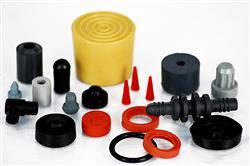Custom Molded Rubber Components
Rubber molding is a process where raw rubber or elastomer is pressed or injected into heated molds, then cooled and cured to help the product retain its shape. Rubber molding is used to create rubber seals, O-rings, gaskets, plugs and other components used by numerous industries and for a variety of applications.
Benefits of Using Molded Rubber Components
Due to its affordability, flexibility, and versatility, rubber is the preferred material choice for a number of applications. Rubber is a reliable and durable product that will withstand heat, cold and other elements without losing its flexibility. Additional benefits of molded rubber components include:
- Low cost and fast production time
- Strength and durability
- Can be formed into virtually any shape
- Resistant to many chemicals
Ace Seal has the capabilities to manufacture custom seals for any application and we can handle any production run size to create the most efficient and cost-effective solutions. It it’s rubber or plastic, we can do it.
Quality Custom Seals, O-rings & Gaskets
The Ace Seal level of quality doesn’t just happen, continuous upgrades and process improvements of our tooling and process technologies ensures that we are among the world leaders in custom rubber molding product manufacturing.
We work with customers from design stage to production to ensure the very best quality component. Custom seals, molded rubber and plastic parts manufactured by Ace Seal will meet or exceed your exact specifications. Whether you need a prototype run or high-volume production, we offer single or multi-cavity tooling with competitive tooling costs. We also offer secondary cleaning services and custom packaging to meet customer specifications.
Our factory is ISO/TS 16949:2009 & QS-9000 & ISO-9001:2008 approved. Contact Ace Seal to learn more about our capabilities or request a quote for pricing, technical help, or to place an order.
Custom Molded Rubber Parts for Any Industry
Custom rubber molded components from Ace Seal are a perfect solution for the following industries:
- Semiconductor
- Military
- Medical
- Industrial (OEM)
- Food Processing
- Electronics
- Automotive
- Agriculture
- Water Reclamation Filtration
- Municipalities
- Solar
- Aerospace
- Biotechnology
- Gas/Oil
Custom Rubber Molding Considerations
Materials are chosen for each molded rubber component based on operating environment and how the product will be used. For example, a component used in medical devices will need to meet different industry requirements than a rubber component being used for automotive or mechanical applications. Considerations in choosing an appropriate material include:
- Resistance to oils, gases and fuels
- Potential environmental exposure
- Minimum and maximum temperature tolerance
- Certifications and industry requirements, when applicable
- Production cost
Molded Rubber Material Options
Ace Seal works with a variety of rubber materials to meet your application needs. Our material properties comparison chart provides you with information regarding tensile strength, chemical resistance, heat and cold tolerance, and other properties for many of the common rubber materials we work with. View our temperature compatibility chart for a comparison of normal recommended operation temperatures for several of the most common rubber elastomers.
- AFLAS®
- Buna/Nitrile
- Butyl
- EPDM (Sulfur Cured/Platinum Cured/Peroxide Cured)
- Fluorosilicone
- HNBR
- Hypalon
- KALREZ® & CHEMRAZ®
- NBR
- Neoprene
- Polyurethane
- Silicone
- Urethane
- Viton®
Rubber Molding Processes and Advantages
The rubber molding process typically involves one of three processes: Compression molding, and injection molding.
Rubber Compression Molding
Compression molding is our most frequently used rubber molding process and involves placing sheets or pieces of cold, preformed rubber over a heated mold. A combination of heat and pressure is used to press the rubber into the mold and the product is then left to cool. After cooling, the molded rubber component is removed, and the flash is trimmed away.
Compression Molding Advantages:
- A versatile and cost-effective tooling process that allows for high cavity density in each mold and faster turnaround times.
- Able to produce a high volume of molded components in one cycle.
- The least expensive production option.
- A lower waste process, as material is placed directly on the mold instead of running through various components.
Compression Molding Disadvantages :
- It cannot produce tight tolerances and does not work for complex configurations.
- There can be issues with part consistency if the preformed rubber is not properly placed on the mold.
- The deflashing process can add to production time.
Rubber Injection Molding
Injection molding is a process where pre-heated material is injected into a heated mold through a sprue and a series of channels known as runners, filling each cavity evenly. After the mold cools, the cured parts are removed, and any flash is trimmed away. Since this process requires a pass (or, “worm holes”) to deliver the heated rubber into each cavity, it can result in more waste unless a heated pass is utilized.
Injection Molding Advantages:
- Tighter tolerances than other processes
- A faster, fully automated production time
- When heated runners are used, this process produces less material waste than other methods.
Injection Molding Disadvantages:
- Injection molding accommodates fewer cavities that other molds, requiring more cycles when creating a high volume of products.
- If unheated runners are used, material can build up in the system, increasing waste.
- Higher tooling costs than other processes
- The complexity of the system can lead to issues with molds not filling all the way or foreign particles being injected into the molds.
Contact Ace Seal for Your Custom Molded Rubber Components
Request a quote or contact Ace Seal to speak with a product specialist about Custom Molded Rubber Parts.



